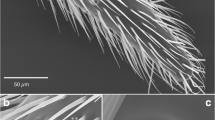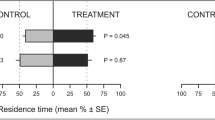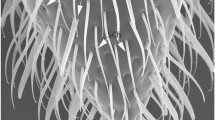Abstract
Electroantennograms (EAGs) from male and femaleIps avulsus, I. calligraphus, andI. grandicollis to their pheromones and selected host odorants or kairomones verified the presence of antennal olfactory receptors in both sexes of each species capable of detecting ipsdienol, ipsenol,cis- andtrans-verbenol,endo-brevicomin α-pinene, frontalin, and verbenone. Each species possesses receptors with lower thresholds and in greater abundance for the compounds they produce and to which they are behaviorally most responsive. Detection of bothIps andDendroctonus pheromones by the three cohabiting species provides a sensory basis for olfactory interactions among the species. Differences in both threshold and saturation levels for EAGs for the various behavioral chemicals could denote differences in specific behavioral roles for each compound.
Similar content being viewed by others
References
Billings, R.F. 1985. Southern pine bark beetles and associated insects: Effects of rapidly-released host volatiles on response to aggregation pheromones.Z. Angew. Entomol. 99:483–491.
Birch, M.C., andSvihra, P. 1979. Novel approaches to forest insect control. Exploiting olfactory interactions between species of Scolytidae, pp. 135–138,in W.E. Waters (ed.). Current Topics in Forest Entomology. John Wiley & Sons, New York.
Birch, M.C., Svihra, P., Paine, T.D., andMiller, J.C. 1980. Influence of chemically mediated behavior on host tree colonization by four cohabiting species of bark beetles.J. Chem. Ecol. 6:395–414.
Birgersson, G., Schlyter, F., Lofqvist, J., andBergstrom, G. 1984. Quantitative variation of pheromone components in the spruce bark beetleIps typographus from different attack phases.J. Chem. Ecol. 10:1029–1055.
Browne, L.E. 1972. An emergence cage and refrigerated collector for wood-boring insects and their associates.J. Econ. Entomol. 65:1499–1501.
Dickens, J.C. 1978. Olfactory perception of pheromone and host-odour enantiomers byIps typographus (Coleoptera: Scolytidae).Entomol. Exp Appl. 24:136–142.
Dickens, J.C. 1979. Electrophysiological investigations of olfaction in bark beetles.Mitt. Schweiz. Entomol. Ges. 52:203–216.
Dickens, J.C. 1981. Behavioral and electrophysiolocal responses of the bark beetle,Ips typographus, to potential pheromone components.Physiol. Entomol. 6:251–261.
Dickens, J.C., andPayne, T.L. 1977. Bark beetle olfaction: Pheromone receptor system inDendroctonus frontalis.J. Insect. Physiol. 23:481–489.
Dickens, J.C., andPayne, T.L. 1978. Structure and function of the sensilla on the antennal club of the southern pine beetle,Dendroctonus frontalis (Zimmerman) (Coleoptera: Scolytidae).Int. J. Insect. Morphol. Embryol. 7:251–265.
Dixon, W.N., andPayne, T.L. 1979. Sequence of arrival and spatial distribution of entomophagous and associated insects of southern pine beetle-infested trees.Texas Agric. Exp. Stn. MP 1432. 27 pp.
Dixon, W.M., andPayne, T.L. 1980. Attraction of entomophagous and associate insects of the southern pine beetle to beetle- and host tree-produced volatiles.J. Ga. Entomol. Soc. 15:378–389.
Hedden, R., Vité, J.P., andMori, K. 1976. Synergistic effect of a pheromone and a kairomone on host selection and colonisation byIps avulsus.Nature 261:696–697.
Hertel, G.D., Hain, F.P., andAnderson, R.F. 1969. Response ofIps grandicollis (Coleoptera: Scolytidae) to the attractant produced by attacking male beetles.Can. Entomol. 101:1084–1091.
Hughes, P.R. 1973.Dendroctonous: Production of pheromones and related compounds in response to host monoterpenes.Z. Angew. Entomol. 73:294–312.
Hughes, P.R. 1974. Myrcene: A precursor of pheromones inIps beetles.J. Insect Physiol. 20:1271–1275.
Hughes, P.R. 1975. Pheromones ofDendroctonus: Origin of α-pinene oxidation products present in emergent adults.Insect Physiol. 21:687–691.
Kinzer, G.W., Fentiman, A.F., Page, T.E., Jr., Foltz, J.L., Vité, J.P., andPitman, G.B. 1969. Bark beetle attractants: Identification; synthesis and field bioassay of a new compound isolated fromDendroctonus.Nature 221:723–726.
Mustaparta, H., Angst, M.E., andLanier, G.N. 1979. Specialization of olfactory cells to insect- and host-produced volatiles in the bark beetle speciesIps pini.J. Chem. Ecol. 5:109–123.
Paine, T.D., Birch, M.C., andSvihra, P. 1981. Niche breadth and resource partitioning by four sympatric species of bark beetles (Coleoptera: Scolytidae).Oecologia 48:1–6.
Payne, T.L. 1970. Electrophysiological investigations on response to pheromones in bark beetles.Contrib. Boyce Thompson Inst. 24:275–282.
Payne, T.L. 1971. Bark beetle olfaction. 1. Electroantennogram responses of the southern pine beetle (Coleoptera: Scolytidae) to its aggregation pheromone frontalin.Ann. Entomol. Soc. Am. 64:266–268.
Payne, T.L. 1975. Bark beetle olfaction. III. Antennal olfactory responsiveness ofDendroctonus frontalis Zimmerman andD. brevicomis LeConte (Coleoptera: Scolytidae) to aggregation pheromones and host tree terpene hydrocarbons.J. Chem. Ecol. 1:233–242.
Payne, T.L., andDickens, J.C. 1976. Adaptation to determine receptor system specificity in insect olfactory communication.J. Insect. Physiol. 22:1569–1572.
Payne, T.L., Richerson, J.V., Dickens, J.C., West, J.R., Mori, K., Berisford, C.W., Hed-Den, R.L., Vité, J.P., andBlum, M.S. 1982. Southern pine beetle: Olfactory receptor and behavior discrimination of enantiomers of the attractant pheromone frontalin.J. Chem. Ecol. 8:873–881.
Payne, T.L., Billings, R.F., Delorme, J.D., Andryszak, N.A., Bartels, J., Francke, W., andVité, J.P. 1987. Kairomonal-Pheromonal system in the black turpentine beetle,Dendroctonus terebans (01.).Z. Angew. Entomol. 103:15–22.
Pitman, G.B., Vité, J.P., Kinzer, G.W., andFentiman, A.F. 1969. Specificity of population aggregating pheromones inDendroctonus.J. Insect Physiol. 15:363–366.
Renwick, J.A.A. 1967. Identification of two oxygenated terpenes from the bark beetleDendroctonus frontalis andDendroctonus brevicomis.Contrib. Boyce Thompson Inst. 23:355–360.
Renwick, J.A.A., andVité, J.P. 1968. Isolation of the population aggregating pheromone of the southern pine beetle.Contrib. Boyce Thompson Inst. 24:65–68.
Renwick, J.A.A., andVité, J.P. 1972. Pheromones and host volatiles that govern aggregation of the six-spined engraver beetle,Ips calligraphus.J. Insect Physiol. 18:1215–1219.
Richerson, J.V., andPayne, T.L. 1979. Effects of bark beetle inhibitors on landing and attack behavior of the southern beetle and beetle associates.Environ. Entomol. 8:360–364.
Schneider, D. 1957a. Elektrophysiologische Untersuchungen von Chemo- und mechanorezeptoren der antenne des SeidenspinnersBombyx mon. Z.Vergl. Physiol. 40:8–41.
Schneider, D. 1957b. Electrophysiological investigation on the antennal receptors of the silk moth during chemical and mechanical stimulation.Experientia 15:89–91.
Snedecor, G.W., andCochran, W.G. 1967. Statistical Methods, 6th ed. Iowa State University Press, Iowa. 593 pp.
Stewart, T.E., Plummer, E.L., McCandless, L.L., West, J.R., andSilverstein, R.M. 1977. Determination of enantiomer composition of several bicyclic ketal insect pheromone components.J. Chem. Ecol. 3:27–43.
Svihra, P. 1982. Influence of opposite sex on attraction produced by pioneer sex of four bark beetle species cohabiting pine in the southern United States.J. Chem. Ecol. 8:373–378.
Svihra, P., Paine, T.D., andBirch, B.C. 1980. Interspecific olfactory communications in southern pine beetles.Naturwissenschaften 67:518–519.
Vité, J.P., andFrancke, W. 1976. The aggregation pheromones of bark beetles: Progress and problems.Naturwissenschaften 63:550–555.
Vité, J.P., andRenwick, J.A.A. 1971a. Inhibition ofDendroctonus frontalis response to frontalin by isomers of brevicomin.Naturwissenschaften 58:418.
Vité, J.P., andRenwick, J.A.A. 1971b. Population aggregating pheromone in the bark beetle,Ips grandicollis.J. Insect Physiol. 17:1699–1704.
Vité, J.P., Gara, R.I., andVon Scheller, H.D. 1964. Field observations on the response to attractants of bark beetles infesting southern pines.Contrib. Boyce Thompson Inst. 22:461–470.
Vité, J.P., Bakke, A., andRenwick, J.A.A. 1972. Pheromones inIps (Coleoptera: Scolytidae): Occurrence and production.Can. Entomol. 104:1967–1975.
Vité, J.P., Hedden, R., andMori, K. 1976a.Ips grandicollis: Field response to the optically pure pheromone.Naturwissenschaften 63:43.
Vité, J.P., Klimetzek, D., Loskant, G., Hedden, R., andMori, K. 1976b. Chirality of insect pheromones: Response interruption by inactive antipodes.Naturwissenschaften 63:582–583.
Vité, J.P., Ohloff, G., andBillings, R.F. 1978. Pheromonal chirality and integrity of aggregation response in southern species of the bark beetleIps. sp.Nature 272:817–818.
Werner, R.A. 1972. Response of the beetle,Ips grandicollis, to combinations of host and insect produced attractants.J. Insect Physiol. 18:1403–1412.
Author information
Authors and Affiliations
Additional information
Texas Agricultural Experiment Station Paper Number TA-22463. This research was supported in part by McIntire-Stennis Project 1525, USDA-CR grants 85-CRCR-1-1856 and 86-CRCR-2019 and NATO Collaborative Research Grant 86-0710. The findings, opinions, and recommendations expressed herein are those of the authors and not necessarily those of the U.S. Department of Agriculture. All programs and information of the Texas Agricultural Experiment Station are available without regard to race, ethnic origin, religion, sex, or age.
Mention of a trademark, proprietary product, or vendor does not constitute a guarantee or warranty of the product by the U.S. Department of Agriculture and does not imply its approval to the exclusion of other products or vendors that may also be suitable.
Rights and permissions
About this article
Cite this article
Smith, M.T., Busch, G.R., Payne, T.L. et al. Antennal olfactory responsiveness of three sympatricIps species [Ips avulsus (Eichhoff),Ips calligraphus (Germar),Ips grandicollis (Eichhoff)], to intra- and interspecific behavioral chemicals. J Chem Ecol 14, 1289–1304 (1988). https://doi.org/10.1007/BF01019353
Received:
Accepted:
Issue Date:
DOI: https://doi.org/10.1007/BF01019353




